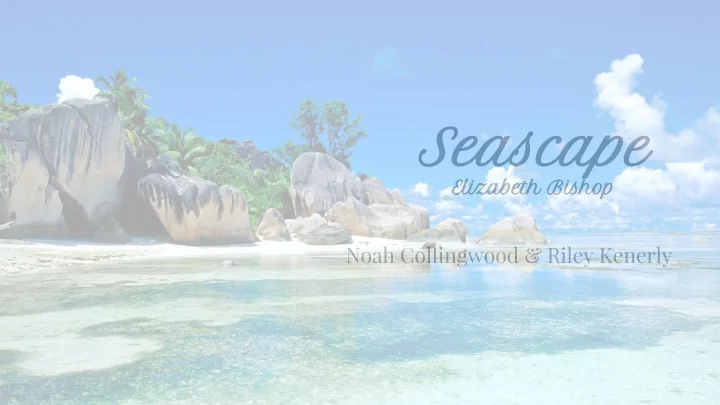

Seascape Elizabeth Bishop Noah Collingwood & Riley Kenerly
A Reading of the Poem This celestial seascape, with white herons got up as And the beautiful pea-green back-pasture angels, Where occasionally a fish jumps, like a wildflower Flying high as they want and as far as they want In an ornamental spray of spray; sidewise This cartoon by Raphael for a tapestry for a Pope: In tiers and tiers of immaculate reflections; The whole region, from the highest heron It does look like heaven. Down to the weightless mangrove island With bright green leaves edged neatly with bird-droppings Like illumination in silver, And down to the suggestively Gothic arches of the mangrove roots
A Reading of the Poem But a skeletal lighthouse standing there But has something to do with blackness and a strong glare In black and white clerical dress, And when it gets dark he will remember something Who lives on his nerves, thinks he knows better. Strongly worded to say on the subject. He thinks that hell rages below his iron feet, That that is why the shallow water is so warm, And he knows that heaven is not like this. Heaven is not like flying or swimming,
Guiding Question #1 How does Elizabeth Bishop comment on the use of fear mongering by religious officials? What specific criticisms on this topic are conveyed through her writing?
Symbolism “But a skeletal lighthouse standing there/ In black and white clerical dress,/ Who lives on his nerves, thinks he knows better./ He thinks that hell rages below his iron feet,” (14-17). Skeletal Lighthouse Black and White Clerical Dress Iron Feet Rigid and exposed Definitive nature of clergy The strength of his beliefs Death and mortality A single interpretation Permanency within this world Believes heaven is worth fearing No room for alternative though Significance of hell beneath the feet Takes advantage of people’s fear and controls them
Juxtaposition and Allegory The structure of the poem can be dissected into two contrasting sections which are juxtaposed for thematic effect. Heaven is: Celestial, Immaculate, Weightless, Beautiful, Illuminated. -or- Heaven is: Blackness, Dark, Judgemental, Contained. Fearful interpretation and teaching of religion removes the themes of love and warmth which are readily present within the first description of heaven. “And when it gets dark he will remember something/ Strongly worded to say on the subject”
Guiding Question #2 What is the significance of the natural and the artificial within “Seascape” by Elizabeth Bishop? Through what specific literary devices does she convey this meaning?
Symbolism The Natural- White herons- White=purity, herons=angels ● Mangroves- Thick, hard to see through/past ● Green Leaves- Green=Purity, naivety ● The fish- Jesus fish! ● The word ichthys means fish in Greek, but the letters are also the initials of five Greek words ○ that mean Jesus Christ, Son of God, Savior” ( I esous Ch ristos Th eou Y ios S oter)” Shallow Water- Bishop uses “shallow waters” to allude to humanity’s ● shallow lifestyles- living a “godly” life just to get into heaven, not because it's the right thing to do. “He thinks that Hell rages below his iron feet,/that that is why the shallow water is so warm/” ○ The water is so warm because hell is closer than we think ■
Symbolism The Artificial- “Immaculate Reflections”- Bishop the white herons’ “immaculate ● reflections”, to symbolise an angel The Fish- Again, Jesus fish! ● The Lighthouse- A lighthouse is supposed to represent light, and create a ● pathway for those who are lost (lighthouse=pope). This lighthouse is “skeletal” and dark...corruption in the church?! ○ Iron Feet- When the lighthouse (pope) is described to have “iron feet”, this ● alludes to the idea that popes believe that they are the end-all-be-all of the church, and are HIGHLY set in their ideas and ways.
Metaphor “/The suggestively Gothic arches of the mangrove roots/” The comparison of the mangrove roots to Gothic arches (often seen in ● architecture of churches) at the beginning of the poem shows the reader that Bishop is comparing the natural (nature) to the artificial (religion) “/But a skeletal lighthouse standing there/in black and white clerical dress,/” By comparing something commonly found in a seascape (the lighthouse) to ● someone in “black and white clerical dress” (a pope), Bishop was able to introduce the idea of a pope and a lighthouse having a similar job. When Bishop called the lighthouse “skeletal” she began to introduce the idea that the ○ church/pope are a little shadier than they would like to appear
Ambiguity Bishop uses a lot of ambiguity throughout this poem- mainly because she is writing about religion, which is a highly ambiguous concept “ /Heaven is not like flying or swimming, / but has something to do with blackness and a strong glare / and when it gets dark he will remember something/ strongly worded to say on the subject.” The closing line in the poem is especially significant, because the reader really has no way of knowing what “something strongly worded” would be and what “the subject” really is.
Group Discussion 1. To what extent does the shift in tone in the middle of the poem hint at Bishop’s views on religion and the corruption in the church? 2. What roles does ambiguity play throughout Bishop’s poetry? 3. With reference to one other poem, discuss the themes of the natural and the artificial with Bishop’s poems.
Recommend
More recommend